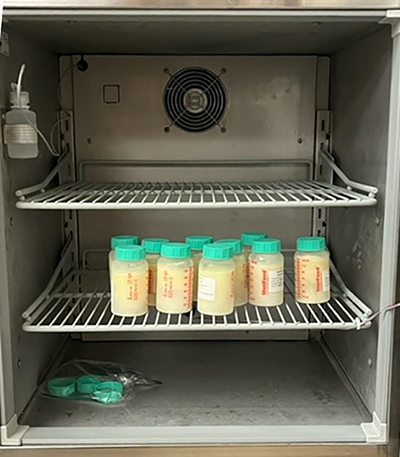Exclusive Human Milk Feeding QI Initiative
Froedtert West Bend Hospital Birth Center’s breastfeeding initiative began in May 2019 with a commitment to promoting and supporting breastfeeding practices. Froedtert West Bend set a goal to increase their exclusive breastfeeding rate to 70% for 2020; an increase over their 2018 rate of 66% (exceeding The Joint Commission goal of 52.9% or above).

Several measures were implemented as defined by a multidisciplinary team of lactation consultants, OB providers, the neonatology director, pediatric providers, and birth center staff. To help increase the expertise on the unit, Froedtert West Bend added two Certified Lactation Consultants (CLC) who also worked as labor nurses, to the three International Board-Certified Lactation Consultants (IBCLC) already on staff. All nurses on the unit were trained and educated on hand expression of milk and shown how easily hand expression can be taught to mothers. These methods were reviewed with mothers before formula was given.
 The donor milk freezer which is located in the newborn nursery.
The donor milk freezer which is located in the newborn nursery.
Additionally, an antenatal hand expression study (expression of early milk and colostrum in the final few weeks of pregnancy) was started with diabetic patients, which included hand expression during labor to collect breastmilk to be given after delivery to babies with low blood sugar, instead of formula. To further promote exclusive human milk feeding, whether it is mother’s milk or donor human milk, Froedtert West Bend worked with Mother’s Milk Bank of the Great Lakes in implementing pasteurized human donor milk (PHDM). This process took months to implement, including working with the multidisciplinary team to gain approval from hospital administration and hospital infection prevention, and required writing policies and procedures, educating staff, setting up monitored refrigerators and freezers, using proper warming protocol, producing educational material and consent forms for patients, and analyzing algorithms for decision making on when to use donor milk. Froedtert West Bend wanted patients to understand and be reassured that PHDM is screened, pooled, tested, and pasteurized to eliminate harmful bacteria or other potential infecting organisms. The first PHDM was used September 11, 2019. Also, during this time, the perinatal coordinator joined a collaborative through the Wisconsin Perinatal Quality Collaborative (WisPQC) comprised of other hospitals working to increase exclusive human milk feeding, sharing lessons learned.
Froedtert West Bend’s focus on patient education continued throughout 2020, and included lactation consultants:
- Seeing all patients daily
- Reformatting the facility’s lactation sheets to color-coded sheets and providing these to all breastfeeding patients in an informational packet
- Continuation of a monthly lactation support group
- Sending My Chart messages as a follow up to patients
In conjunction, the perinatal coordinator added information about the importance of breastfeeding into prenatal education into Baby Scripts, the prenatal education app that Froedtert uses with patients. The lactation consultants and perinatal coordinator reviewed the feeding trends monthly (see table 1). While no specific trends were identified over time, chart reviews found additional ways to advocate breastfeeding. Prenatal education was held virtually and through the app. Lactation support continued to be offered as an outpatient service for patients needing more intensive support on a 1:1 basis.
Table 1*
Monthly breakdown of feedings
- Exclusive mom's milk
- Mom's milk and donor
- Mom's milk and formula
- All formula
- Breast milk, donor and formula
*Used for discussion with staff for QI
In 2021, the focus continued with education. Staff had annual breastfeeding education “back to basics,” including feeding patterns in the first 24 hours, review of hand expression, troubleshooting problems with feeds at change of shift, and trying to put baby skin-to-skin before giving report (so the next RN could help with the baby’s latch). This addressed trends seen in previous months of infants going too long between feeds due to needing assistance with feeding at change of shift.
 Staff education board where different breastfeeding information was posted with breastfeeding graphs.
Staff education board where different breastfeeding information was posted with breastfeeding graphs.
The perinatal coordinator and lactation coordinator continued to focus on chart review. When goals were not met, opportunities for improvement were discussed and shared with staff. For example, if a baby was breastfeeding and was given formula as well they found a progress note was missed explaining the offer of donor milk being an option. This led to an opportunity for quality improvement where the perinatal coordinator and the lactation consultant would meet with RNs and discuss the any missed opportunity to document nursing education. This education continued with focus on discharge teaching for breastfeeding, allowing staff nurses to be involved in discharge discussions with the patient. This allowed the lactation consultant to have more time to work on feedings with families.
Goals identified for 2022 include education for providers and staff regarding management of plugged ducts and mastitis reflecting new emerging guidelines. In light of PHMD shortage nationwide, staff was encouraged to continually re-evaluate the need for use of PHDM, watching for indications that improved breastfeeding may allow discontinuation of additional supplementation.
Each month the perinatal coordinator, with the quality department, share the exclusive human milk feeding rate with the birth center staff compared to our goal to date. The interdisciplinary team reviews the data during their bi-monthly meetings as well. This helped to visualize, with graphs, how our interventions were working. Froedtert West Bend has exceeded their goal of exclusive breastfeeding and has seen a steady rise for the last two calendar years and into 2022.
